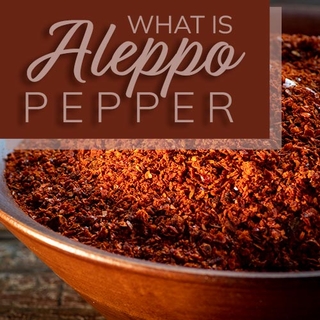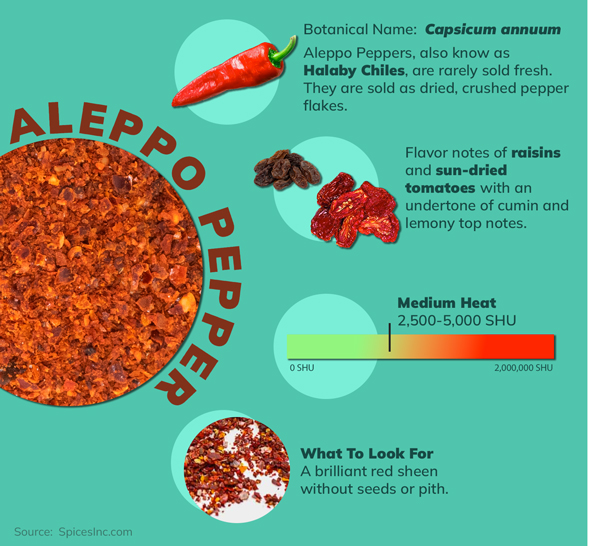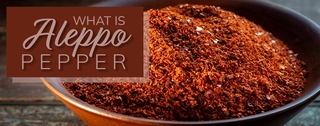What Is Aleppo Pepper?

What is Aleppo Pepper?
Aleppo peppers are mildly spicy and playfully sweet. They deliver a rich flavor that’s a little bit like raisin and a little bit like sun-dried tomatoes. Aleppo pepper has an undertone of earthy cumin and lemony top notes. The heat comes in slowly and then dissipates, leaving behind the tart citric top notes.
 These peppers, also known as Halaby chiles, originated in the eastern Mediterranean region. The city of Aleppo can be found in Syria, just south of Turkey. It is one of the oldest continuously inhabited cities in the world, with evidence that it was inhabited as long as 5,000 years ago. It is located directly along what was once the path of the famous trade route, the Silk Road. Halab—as in “Halaby”—is the Arabic word for the city of Aleppo, so no matter what name you call this bright red chile, it means “Aleppo pepper”.
These peppers, also known as Halaby chiles, originated in the eastern Mediterranean region. The city of Aleppo can be found in Syria, just south of Turkey. It is one of the oldest continuously inhabited cities in the world, with evidence that it was inhabited as long as 5,000 years ago. It is located directly along what was once the path of the famous trade route, the Silk Road. Halab—as in “Halaby”—is the Arabic word for the city of Aleppo, so no matter what name you call this bright red chile, it means “Aleppo pepper”.
You’ll rarely find Aleppo peppers sold fresh or whole; they are almost exclusively sold as dried, crushed pepper flakes. The climate in which these peppers developed is particularly well-suited for drying fresh chiles in the sun. This easy preservation method makes them perfect for longer-term storage and easy to ship.
Is Aleppo Pepper Hot?
Aleppo Peppers deliver a little heat but are mostly known for their complex chile pepper flavor, which is fruity, tart, sweet, and a little earthy. They measure 2,500-5,000 Scoville Heat Units (SHU), the scale developed in 1912 to quantify the perceived heat of capsicums. This makes them a medium-heat chile, but they are still on the mild side of the medium measurement.
When looking for a top-quality jar of Aleppo pepper, look for peppers with a brilliant red sheen and vibrancy. A fresh Halaby chile has relatively thick flesh for its size, so the flakes should look slightly fuller than something like Guajillo chile flakes, which come from a pepper with thinner flesh.
Ground Aleppo pepper flakes do not incorporate seeds or interior, pithy flesh in the grind, so the flakes should be uniformly red, with some accounting for variations in the colors of the dried peppers themselves.
They should smell fruity and sweet, with spicy heat tucking in behind the raisin-like aroma.
Table of Contents
Aleppo Pepper Substitutes
You could use several other peppers to substitute for the Aleppo pepper. The first option is its cousin, the Maras pepper.
Maras chiles developed in the same region as Aleppo, a bit further to the north, in Turkey. Maras chiles are fruity and earthy, with a tart, acidic note. Like Aleppo peppers, they are processed without seeds or pith, so you will have nothing but dried chile fruit. They are a little hotter than Aleppo peppers, measuring 4,000-8,000 SHU, so you may want to test the heat before using, but the heat difference is not that pronounced, so you can still use them in a mostly 1:1 ratio.
Guajillo Chile Flakes have a comparable heat measurement; most fall between 2,500-5,000 SHU, though you will occasionally encounter a Guajillo that is twice as hot as this. They are also fruity and sweet but taste more like cherries than raisins. The skin of the guajillo pepper is thinner, so the flakes are thinner, and the inclusion of pith and seeds with the pepper flakes gives them a touch of bitterness. Use these chiles in a 1:1 ratio, but be aware of their flavor.
Korean Chili Flakes are hotter than Aleppo peppers, measuring between 4,000-8,000 SHU. They are similarly bright and fruity but not as complex and lack the earthiness of Aleppo pepper. They are processed without seeds or pith and are just fruity and hot, without bitterness. Use a 1:1 ratio, perhaps with a touch less pepper flake and a pinch of cumin, to include a bit of earthy flavor.

Sweet Paprika and Cayenne Chile Powder can be combined to swap in for Aleppo pepper, if necessary. Sweet Paprika has an almost negligible heat level but is gentle, fruity, and warming. Cayenne chile powder delivers a clean heat. Its flavor is very mild, as it’s valued chiefly for its heat. It measures roughly 30,000 SHU. These ingredients can be combined in a 4:1 ratio—use one teaspoon of Cayenne to every four teaspoons of Paprika—to approximate the taste and heat of Aleppo. However, Aleppo will still be sweeter and more complex. You can use this mixture in a 1:1 ratio, though it may still be a little hotter than standard Aleppo pepper.
How Can I Use Aleppo Pepper?
Aleppo Pepper can be used the same way as any red pepper flake. Sprinkle it over eggs, pasta, or pizza to heighten the flavor, and add a little heat. It pairs wonderfully with foods with Middle Eastern or Mediterranean flair, so add it to punch up the heat and color in hummus, baba ghanoush, or in the classic red pepper dip, muhammara. It works wonderfully in a seasoning rub for kebabs, lamb, or grilled chicken thighs.
Because of its sweetness, Aleppo pepper blends well with chocolate. Try Aleppo pepper mixed into brownie batter or chocolate bark.
Where is Aleppo Pepper From?
The story of the Aleppo Pepper begins, as most pepper stories do, deep in the heart of central and South America, circa the late 15th century. Christopher Columbus made his way to the Americas. He returned to Spain with offerings that told a story of a land rich with resources, thus opening the passage westward to European exploration. Among Columbus’s spoils were spicy capsicums, but their fiery heat was not particularly favored in Spain. They were passed along to Spanish monks to see if the peppers had medicinal uses. From Spain, the peppers went to Portugal, then down through Morocco and northern Africa. Trade carried the peppers across north Africa and into Syria and Turkey; the pepper plant’s proclivities for cross-breeding and the terroir properties that peppers display eventually developed into the characteristic Aleppo pepper.
the late 15th century. Christopher Columbus made his way to the Americas. He returned to Spain with offerings that told a story of a land rich with resources, thus opening the passage westward to European exploration. Among Columbus’s spoils were spicy capsicums, but their fiery heat was not particularly favored in Spain. They were passed along to Spanish monks to see if the peppers had medicinal uses. From Spain, the peppers went to Portugal, then down through Morocco and northern Africa. Trade carried the peppers across north Africa and into Syria and Turkey; the pepper plant’s proclivities for cross-breeding and the terroir properties that peppers display eventually developed into the characteristic Aleppo pepper.
Traditionally, to clean the Aleppo pepper, it is first wiped clean with a white cloth. Then it’s cut in half and put out to dry on the sunny, arid rooftops of Aleppo. Then it’s pounded into large flakes instead of powder before drying thoroughly.
Most Aleppo pepper available now in the US comes from Turkey instead of Syria. Syrian agriculture and infrastructure were devastated in the turmoil of the Syrian civil war, which began in 2011 and is still ongoing. Pepper seeds were transported in the pockets of refugees into neighboring countries and grown there, surviving in the hands of people who have tasted this unique spice and recognize its complex appeal. This sweet, spicy, fruity, earthy pepper symbolizes the love of country and culture, evoking Aleppo City's ancient roots in resilience and perseverance. And in its seeds, the Aleppo pepper carries the hope that someday, like the people of that region, the Aleppo pepper can return home.

